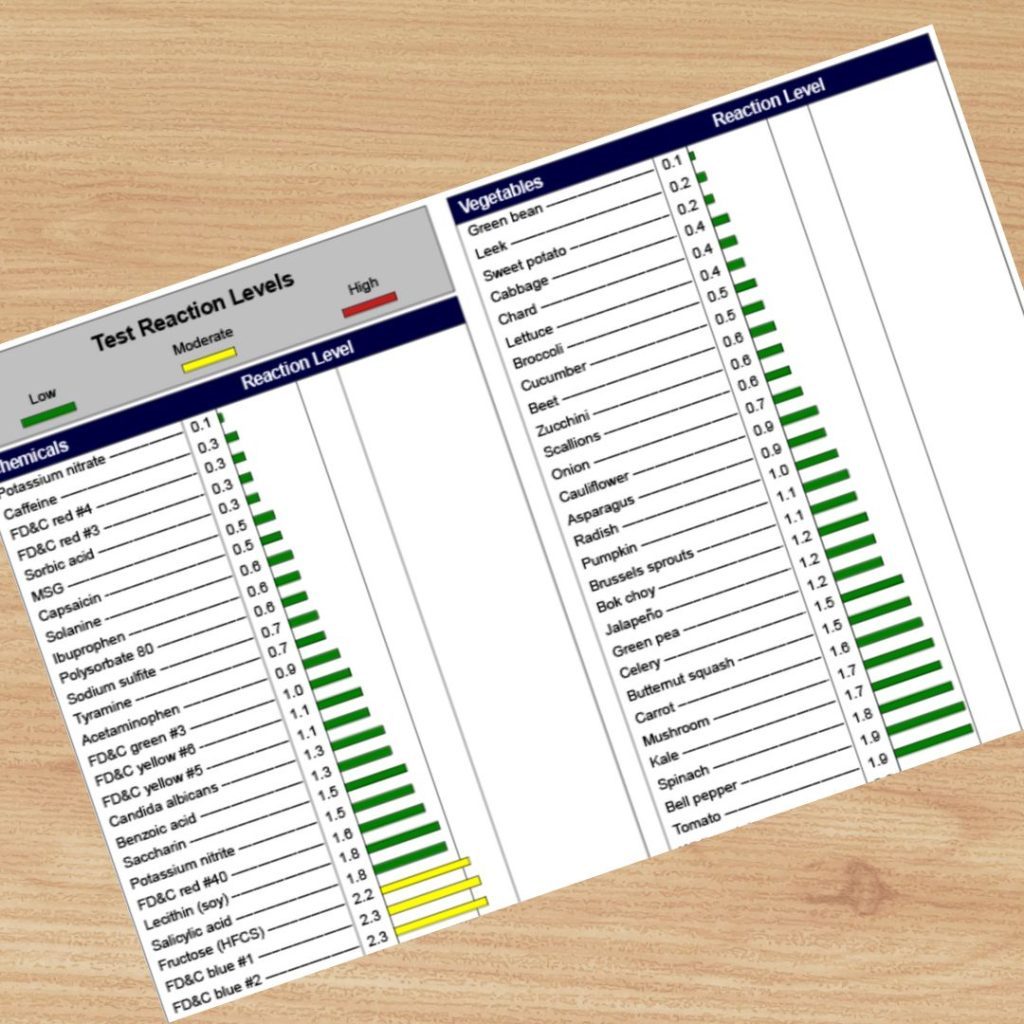What is the MRT Test? Five Reasons to Consider Food Sensitivity Testing Using MRT

There’s one test I’ve used consistently and with amazing results for over ten years now in my practice. It’s the MRT test.
MRT, aka The Mediator Release Test by Oxford Biomedical, is a powerful food sensitivity test that allows you to know what foods your immune system is reacting to.
Why do I exclusively use MRT? Because the MRT test stands apart from other food sensitivity tests on the market. Basically, it works.
Time and time again it has helped my clients relieve symptoms from conditions such as diarrhea, constipation, bloating, abdominal pain, IBS, fatigue, fibromyalgia, chronic headaches and migraines, joint pain, and general inflammation.
Is the MRT test something you should consider? Read on to learn more about what MRT is, how it works, who it works best for, and if food sensitivity testing should be your next step.
What is the MRT Test and How Does it Work?
MRT is a food sensitivity test that measures your unique immune response to over 170 different foods and chemicals.
MRT works by measuring immune mediators that are released when the immune system has identified and tagged a food as harmful.
Mediators are inflammatory agents of the immune system released by antibodies. These mediators include cytokines, prostaglandins, and histamine, among others.
MRT measures this “mediator release,” and it does this by calculating the change in volume of the cells in the blood sample when the food is introduced. The greater the change in volume means more mediators were released, and this means a stronger immune response was triggered.
And a stronger immune response means MORE inflammation (ie more symptoms).
Now, while we do not know which antibodies were triggered, we just know that a reaction happened and to what degree, mild to severe.
This might seem a little complicated, but just remember that MRT can give YOU a more accurate picture of your food triggers because it is are measuring the actual reaction that is happening.
And THAT, in a nutshell, is MRT!
How Does the MRT test Compare to Other Food Sensitivity Tests? (Everlywell, USBiotek, etc)
You might be asking, but how does MRT rank against other common food sensitivity tests on the market?
First, almost all other tests on the market are measuring one antibody, IgG. IgG is an antibody that is involved with food sensitivity reactions, however it’s not the only one. Other antibodies that can cause food sensitivities include IgA and IgM, and even T cells can play a role.
Also, these tests are not looking at mediator release. They are simply measuring the amount of IgG that congregates when your blood sample is introduced to a food. Unfortunately, simply the presence of IgG does not mean there is a reaction occurring.
In fact, research has shown that IgG tests have a lot of false positive results because of this fact. IgG tests are simply not accurate.
Remember, MRT is testing mediator release, so essentially they are testing for reactions from ALL the antibodies in the blood sample, not just IgG. You are getting a much more complete and accurate assessment of your immune system with MRT.
Additionally, many of these tests claim they can test for food sensitivities with just a pinprick of blood. How? It is simply not possible to test the reactivity of hundreds of foods with just a spot of blood.
Overall these IgG tests are just not accurate or helpful. Don’t spend your money on them. If you really need to figure out food sensitivities, use MRT and do it right the first time.
To read more about IgG testing, see my previous post on why IgG tests are a waste of money.
What is the MRT Test Process?
So maybe you are ready to take the leap into food sensitivity testing. If so, let’s talk about the process to get the ball rolling.
The first step is getting your test kit and getting the blood draw. Kits can be obtained from your practitioner OR from Oxford Biomedical. Be aware, however, that often the prices are cheaper (although not always) when going through your practitioner.
Why? Because Oxford knows this process gets the best results when you are working with someone who knows your health and can help you tailor the diet to your needs.
Basically, don’t do this process on your own. Work with someone who can help you decipher the results and make the diet work for you.
Also, your practitioner can help you find the best place to get a blood draw done. It may be right in their office, or they might have local connections to help you get that taken care of. You can even check blood draw locations for your area right on the Oxford website, under the tab for “draw locator.”
Once that is done, you are set! Sit back and within about a week or less you will have your results in hand. Then the hard work begins.
What is the MRT Diet Plan and LEAP Protocol?
The MRT Diet Plan, aka the LEAP protocol, is the plan you follow based on your unique results. No two plans are ever the same.
LEAP stands for Lifestyle, Eating, and Performance. Originally created as a way to help athletes figure out their sensitivities and perform at their best, it’s now widely used for anyone who needs help optimizing health.
LEAP is what we call the protocol that gets you feeling well again.
Understanding the MRT Results
When you first get your results, you will notice each of the 176 foods and chemicals tested will have a bar associated with it: green, yellow, or red.
The “green” foods are your lowest reactive foods. We do not expect you will have reactions when eating these foods. These are your “best” foods, or “safe” foods.
The “yellow” foods are those that tested moderately reactive. While they may not always provoke reactions in small amounts, larger amounts, or in combination with other reactive foods, may be problematic.
Lastly, your “red” foods are your highest reactive foods. These cause more obvious reactions and it may take very little to make you feel unwell.
We avoid ALL yellow and red foods throughout the entire diet process. For yellow reactive foods, we keep them out of your system for at least 3 months. For red foods, at least 6 months.
MRT Diet Phases
Once we start the plan, there are several phases to follow and these are typically customized by your practitioner. Typically the first week, or phase 1, involves eating a select group of your least reactive foods.
These foods are not reactive to your system and should help get you feeling better quickly.
The following phases involve slowly reintroducing the rest of your green foods. What this looks like and how quickly it progresses will be decided by you and your practitioner. Typically this takes another 4-5 weeks.
Eventually, we start adding untested foods into the plan as we continue to expand diet choices, all while being mindful to continue avoiding the yellow and red reactive foods. Again, this is all done in conjunction with your healthcare practitioner to make sure the process is meeting your health goals.
Once you hit the 3-month mark of following the plan, and assuming your symptoms have significantly decreased, careful reintroduction of previously reactive foods can begin. Your system is now (most likely) ready to accept those foods with no further problems.
Tracking Progress
Along the way, you will be keeping a diet journal to record your diet choices. We also ask that you fill out symptom surveys on a regular basis.
This helps us track symptoms and how those change throughout the process. These are very important pieces to the plan and should not be overlooked.
How Fast Will I See Results?
While we expect to see a huge reduction in inflammation even during the first week, do not expect miracles overnight. In my experience, I have seen clients experience noticeable improvements within days, and others feel significantly worse before they start feeling better.
And for some, the improvements don’t start for weeks after beginning the diet plan, particularly for my migraine clients. The key is to trust the process and work closely with your practitioner throughout.
Remember that change is happening. The process works quicker for some than others, but follow the plan and let your body do the work.
What if the MRT Test Doesn’t Work?
This is an excellent question. The test DOES work to remove reactive foods and reduce inflammation. BUT, it cannot necessarily cure other conditions that may be causing some of your symptoms.
In many cases, MRT helps us figure out what is actually going on once we remove problematic foods from the equation.
Once we determine there is more going on than just food sensitivities, your practitioner can then know what to test for and what are the best next steps. In the meantime, following your MRT diet plan should help you feel better as you continue to look for underlying causes.
You may even need to add in components from the low FODMAP diet, especially if you have IBS or other digestive problems.
Additionally, stress can continue to exacerbate food sensitivities and even cause them. Working on your stress both during and after the diet plan is crucial.
To reiterate, MRT testing can help you feel a lot better, but it doesn’t necessarily treat the root cause. You still need to figure out what caused you to develop food sensitivities in the first place.
5 Reasons to Consider MRT Testing
Now that you better understand the MRT test and diet process, here are 5 reasons to consider using this test yourself:
- It’s accurate: You get dependable results based on your unique immune response. No two results or diet plans are ever the same.
- You get a plan, not just test results: MRT is not just a set of results. It’s a guided diet plan that, along with your practitioner, is customized to your health goals.
- It’s (relatively) affordable: Compared to other tests on the market, Oxford has kept their prices quite reasonable. And it’s awesome that the test price is cheaper when working with a qualified practitioner, such as a dietitian like myself.
- You learn a whole new way of eating: While the diet is restrictive to some degree, your creativity with food and learning to make new combinations increases significantly. Many enjoy eating far more after going through this process and retraining their taste buds to enjoy simple yet flavorful foods.
- You WILL see results: As long as you follow the diet plan, you will reduce inflammation. There’s no guarantee that all of your symptoms disappear, but you will see progress.
Final Thoughts
If you are looking for food sensitivity testing options, definitely the consider MRT test.
Rarely if ever do I strongly promote or endorse tests or products, but MRT is one that I trust and use frequently. I’ve used this test with literally hundreds of clients and I get good results almost every time.
As long as a person follows the diet plan, symptoms recede and the body can heal. Sometimes there are additional health concerns we need to address, but MRT is crucial in helping these issues clear up much faster.
As discussed, it’s far more accurate than other methods out there, and it includes a step-by-step diet protocol to walk you through the process.
If you’ve been dealing with IBS, migraines, brain fog, joint pain, fibromyalgia, or other inflammatory symptoms for far too long, please reach out. Let’s see if MRT is the right fit.
